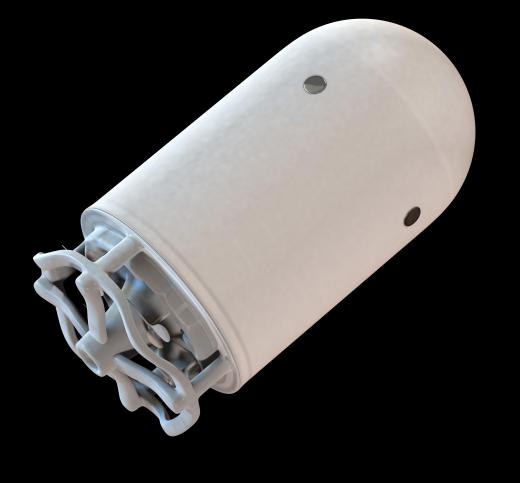What are Nanorobots?
Nanorobots are theoretical microscopic devices measured on the scale of nanometers (1nm equals one millionth of 1 millimeter). When fully realized from the hypothetical stage, they would work at the atomic, molecular and cellular level to perform tasks in both the medical and industrial fields that have heretofore been the stuff of science fiction.
A few generations from now someone diagnosed with cancer might be offered a new alternative to chemotherapy, the traditional treatment of radiation that kills not just cancer cells but healthy human cells as well, causing hair loss, fatigue, nausea, depression, and a host of other symptoms. A doctor practicing nanomedicine would offer the patient an injection of a special type of nanorobot that would seek out cancer cells and destroy them, dispelling the disease at the source, leaving healthy cells untouched. The extent of the hardship to the patient would essentially be a prick to the arm. A person undergoing a nanorobotic treatment could expect to have no awareness of the molecular devices working inside them, other than rapid betterment of their health.

Nanomedicine's nanorobots are so tiny that they can easily traverse the human body. Scientists report the exterior of a nanorobot will likely be constructed of carbon atoms in a diamondoid structure because of its inert properties and strength. Super-smooth surfaces will lessen the likelihood of triggering the body's immune system, allowing the nanorobots to go about their business unimpeded. Glucose or natural body sugars and oxygen might be a source for propulsion, and the nanorobot will have other biochemical or molecular parts depending on its task.

According to current theories, nanorobots will possess at least rudimentary two-way communication; will respond to acoustic signals; and will be able to receive power or even re-programming instructions from an external source via sound waves. A network of special stationary nanorobots might be strategically positioned throughout the body, logging each active nanorobot as it passes, then reporting those results, allowing an interface to keep track of all of the devices in the body. A doctor could not only monitor a patient's progress but change the instructions of the nanorobots in vivo to progress to another stage of healing. When the task is completed, the nanorobots would be flushed from the body.

Molecular nanotechnology (MNT), the umbrella science of nanomedicine, envisions nanorobots manufactured in nanofactories no larger than the average desktop printer. The nanofactories would use nano-scale tools capable of constructing nanorobots to exacting specifications. Design, shape, size and type of atoms, molecules, and computerized components included would be task-specific. Raw material for making the nanorobots would be nearly cost-free, and the process virtually pollution-free, making nanorobots an extremely affordable and highly attractive technology.
The first generation of nanorobots will likely fulfill very simple tasks, becoming more sophisticated as the science progresses. They will be controlled not only through limited design functionality but also through programming and the aforementioned acoustic signaling, which can be used, notably, to turn the nanorobots off.
Robert A. Freitas Jr., author of Nanomedicine, gives us an example of one type of medical nanorobot he has designed that would act as a red blood cell. It consists of carbon atoms in a diamond pattern to create what is basically a tiny, spherical pressurized tank, with "molecular sorting rotors" covering just over one-third of the surface. To make a rough analogy, these molecules would act like the paddles on a riverboat grabbing oxygen (O2) and carbon dioxide (CO2) molecules, which they would then pass into the inner structure of the nanorobot.
The entire nanorobot which Freitas dubbed a respirocyte, consists of 18-billion atoms and can hold up to 9-billion O2 and CO2 molecules, or just over 235 times the capacity of a human red blood cell. This increased capacity is made possible because of the diamond structure supports greater pressures than a human cell. Sensors on the nanorobot would trigger the molecular rotors to either release gasses, or collect them, depending on the needs of the surrounding tissues. A healthy dose of these nanorobots injected into a patient in solution, Freitas explains, would allow someone to comfortably sit underwater near the drain of the backyard pool for nearly four hours, or run at full speed for 15 minutes before taking a breath.
While potential medical and even military applications seem obvious for this one simple type of nanorobot, implications for every-day life are also intriguing. Imagine scuba diving without tank or regulator, but a swarm of respirocytes in your bloodstream; or the 2030 Olympics when, perhaps, super-athletes will not be scanned for drugs, but for nanorobotic augmentation.
Although nanorobots applied to medicine hold a wealth of promise from eradicating disease to reversing the aging process (wrinkles, loss of bone mass and age-related conditions are all treatable at the cellular level), nanorobots are also candidates for industrial applications. In great swarms they might clean the air of carbon dioxide, repair the hole in the ozone, scrub the water of pollutants, and restore our ecosystems.
Early theories in The Engines Of Creation (1986), by "the father of nanotechnology," Eric Drexler, envisioned nanorobots as self-replicating. This idea is now obsolete but at the time the author offered a worst-case scenario as a cautionary note. Runaway microscopic nanobugs exponentially disassembling matter at the cellular level in order to make more copies of themselves - a situation that could rapidly wipe out all life on Earth by changing it into "gray goo." This unlikely but theoretically feasible ecophage triggered a backlash and blockade to funding. The idea of self-replicating nanobugs rapidly became rooted in many popular science fiction themes including Star Trek's nanoalien, the Borg.
Over the years MNT theory continued to evolve eliminating self-replicating nanorobots. This is reflected in Drexler's later work, Nanosystems (1992). The need for more control over the process and position of nanomachines has led to a more mechanical approach, leaving little chance for runaway biological processes to occur.
Nanorobots are poised to bring the next revolution in technology and medicine, replacing the cumbersome and toxic Industrial Age and opening humankind up to incredible possibilities. But while gray goo is no longer a central concern, more potential dangers and abuses of nanotechnology remain under serious consideration by scientists and watchdog groups alike.
AS FEATURED ON:
AS FEATURED ON:













Discussion Comments
How are nanobots made bigger than an apple but fit in a human?
Does it dissolve down and then reform in the body?
What about the cost of nanorobotics?
what if the nanobots go horribly wrong?
Innovate did you not read the whole story. Towards the end it says once the nanorobots are finished their tasks in the body the will be flushed from the body. I thought this would be mostly intelligent people reading this, but there are really some weird questions.
how would the nanobots be controlled once they are inserted into a body?
is nanorobot in work at present? If so, what are the types of nanorobots that are in use now? how are they performing the tasks?
if you think money controls us at the moment, i can see the future being even better. Are we slaves?
wow. sounds great.
wow! that's excellent but i have a small doubt. do our bodies produce antibodies against nano robots?
approximately how many nano robots can be injected into human body for treatments.
Do nanorobots have applications in electronics?
Nanorobots are largely theoretical at this stage, but simple types of nanorobts will be developed before more complex types, and this science is expected to materialize over the next 10-20 years. There is at least one type of nanorobot that has already been created, which IIRC, stores extra oxygen. It could be used for many medical purposes, and also (eventually perhaps) for other applications, such as diving without scuba equipment.
Nanorobots used to repair diseases will be expelled from the body through normal processes, according to scientists.
And yes, nanorobots could be built to repair the ozone, clean the oceans, and even rebuild damaged forests. There are many pluses and minuses to nanotechnology, as indicated by another article here on wiseGEEK.
can nanorobots be used to build ozone?
Referring to my previous post, search for "Nanorobots to help outsourcing" on Google.
Are the nanobots described in this article spin (propaganda), or are they both possible and actual?
What happens to the nanorobots once they have repaired the damaged cells?
Whether Nanorobots are in existence or its just virtual?
Post your comments